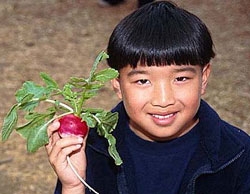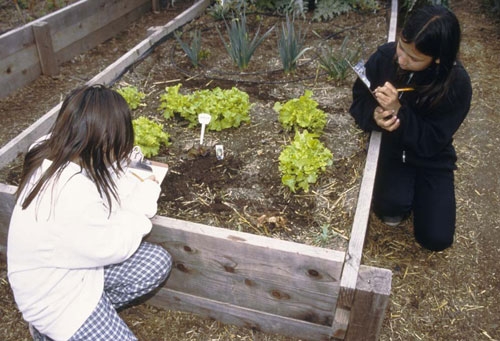School gardens: Important in the past...and the future

In 1909, Ventura schoolteacher Zilda M. Rogers wrote to the Agricultural Experiment Station at the University of California, Berkeley, then the flagship agricultural campus for California’s land grant institution, and a primary proponent and provider of garden education resources for schoolteachers. Rogers wrote in some detail about how her school garden work had progressed, what the successes and failures were, how the children were responding to the opportunity to garden, how her relationship with the children had changed as a result of the garden work, and what she saw as potential for the future.
“With the love of the school garden has grown the desire for a home garden and some of their plots at home are very good. . . . Since commencing the garden work the children have become better companions and friend . . . and to feel that there is a right way of doing everything. . . . It is our garden. . . . We try to carry that spirit into our schoolroom.”
More than 100 years after Rogers wrote those words, school gardens have continued to be cherished in the public school system in which she worked. The Ventura Unified School District has developed a nationally recognized model that links school gardening, nutrition education and a farm-to-school lunch program featuring many locally sourced fruits and vegetables for its 17,000 public school students.
The University of California took note of the success that educators like Rogers were experiencing with school gardens. Being certain to include the words written by her, the University of California published Circular No. 46, which offered information about how to build school garden programs. School gardens were to be an integral part of primary schooling. As the circular declared, “The school garden has come to stay.”
School gardens had been used in parts of Europe as early as 1811, and mention of their value preceded that by nearly two centuries. Philosophers and educational reformers such as John Amos Comenius and Jean-Jacques Rousseau discussed the importance of nature in the education of children; Comenius mentioned gardens specifically.
The use and purpose of school gardens was multifold; gardens provided a place where youth could learn natural sciences (including agriculture) and also acquire vocational skills. Indeed, the very multiplicity of uses and purposes for gardens made it difficult for gardening proponents to firmly anchor gardening in the educational framework and a school’s curriculum. It still does.
The founder of the kindergarten movement, Friedrich Froebel, used gardens as an educational tool. Froebel was influenced by Swiss educational reformer Johann Pestalozzi, who saw a need for balance in education, a balance that incorporated “hands, heart, and head,” words and ideas that would be incorporated nearly two centuries later into the mission of the United States Department of Agriculture’s 4-H youth development program. (These words still guide the work of the University of California’s 4-H program). Educational leaders such as Liberty Hyde Bailey and John Dewey fused ideas of nature study and experiential education with gardening.
Perhaps one of the earliest school garden programs in the United States was developed in 1891, at the George Putnam School in Roxbury, Mass. (Today, the nationally recognized food project also teaches youth about gardening and urban agriculture in the Roxbury neighborhood of Boston). Like others interested in gardening, Henry Lincoln Clapp, who was affiliated with the George Putnam School, traveled to Europe for inspiration. After traveling to Europe and visiting school gardens there, he partnered with the Massachusetts Horticultural Society to create the garden at Putnam; the model was replicated around the state. It was followed in relatively short order by other efforts, including a well-known garden program in New York City: the DeWitt Clinton Farm School.
Gardening became nearly a national craze during the Gilded Age and Progressive Era and “school” gardens enjoyed immense popularity. The United States Department of Agriculture estimated that there were more than 75,000 school gardens by 1906. As their popularity soared, advocates busily supplied a body of literature about school gardening and agricultural education.
One book argued that school gardens were not a “new phase of education,” but rather, an “old one” that was gaining merit for its ability to accomplish a wide variety of needs. School gardens were a way to reconnect urbanized American youth with their agrarian, producer heritage, the Jeffersonian idea of the sturdy yeoman farmer. One author argued for the importance of gardening education and nature study for both urban and rural youth, for “sociological and economic” reasons.
One important reason to garden with urban youth was to teach “children to become producers as well as consumers,” and for the possibility “of turning the tide of population toward the country, thus relieving the crowded conditions of the city.” Other reformers echoed this idea, including Jacob Riis, who said, “The children as well as the grown people were ‘inspired to greater industry and self-dependence.’ They faced about and looked away from the slum toward the country.” It’s now more than a century later, the average American farmer is in his/her late 50s, and the need to reconnect a new generation of youth to the land seems even more compelling. Could the school gardens of today provide the farmers of tomorrow?
The school garden movement received a huge boost during World War I, when the Federal Bureau of Education introduced the United States School Garden Army. During the interwar years and the Great Depression, youth participated in relief gardening. During World War II, a second Victory Garden program swept the nation, but after that, school garden efforts became the exception, not the norm.
The 1970s environmental movement brought renewed interest to the idea of school and youth gardening, and another period of intense growth began in the early 1990s. Interest in farm-to-school has continued to breathe life into the school garden movement, and some states, notably California, have developed legislation to encourage school gardens. (Under the tenure of State Education superintendent Delaine Eastin, a Garden in Every School program was begun. Under Jack O’Connell’s tenure, Assembly Bill 1535, which funded school gardens, was approved).
We should all take note of the tagline for the U.S. government’s youth gardening program in World War I: “A Garden for Every Child. Every Child in a Garden.” Wouldn’t this be a great idea today? With the cuts in school funding, increased classroom size and other challenges, some school garden programs are facing real challenges. They deserve our support, not only in practice (volunteer!) but also by our advocacy for public policies that support youth gardening work in school and community settings. Why not advocate for a nationally mandated curriculum that promotes food systems education in American public schools, something like “Race to the Crop”?
Some of the best models for school gardens lie in our past. But the real potential of school gardens to reduce obesity, encourage a healthy lifestyle, reconnect youth with the food system and to build healthier, vibrant communities is something we can realize today . . . and is something that should be an important concern of our national public policy.
A note to readers: Google Books contains copies of two important books in the school gardening literature of the Progressive Era, (Miller and Greene’s), as well as numerous other Progressive era books pertaining to gardening and agricultural education. To learn more about the United States School Garden Army’s efforts during WWI (a GREAT model for a national curriculum today!), visit the UC Victory Grower website.

Students record plant growth in a school garden.
Posted by Kristofer Young, DC on June 9, 2011 at 10:00 PM